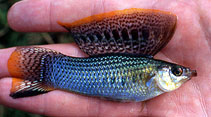| Family: |
Poeciliidae (Poeciliids), subfamily: Poeciliinae |
| Max. size: |
13 cm SL (male/unsexed); 10 cm SL (female) |
| Environment: |
benthopelagic; freshwater; brackish |
| Distribution: |
North Central America: Guatemala (from the tributary of Rio Usumacinta and nearby lakes, Péten) to Mexico (Yucatan Peninsula). |
| Diagnosis: |
Dorsal soft rays (total): 12-16; Anal soft rays: 9-9. This species is distinguished by the following characters: D 12-16; A 9; lateral line scales 28-29; circumpendancular scales 20; no specific body pigmentation, except for the black margined scale; in adult males, the black margins can form spots, extending the rows of spots found on the caudal fin; caudal fin with a slightly produced lower margin (Ref. 84929). |
| Biology: |
This species is like other species in the Poecilia latipinna complex, which occurs in shallow, brackish to freshwater coastal areas such as tidal lagoons, lakes, creeks, and pools. It is also found across a range of turbidity (clear to muddy) and substrate types (mud, sand, clay) and is sometimes associated with submerged or emergent aquatic vegetation (Ref. 125334). |
| IUCN Red List Status: |
Least Concern (LC); Date assessed: 22 March 2018 Ref. (130435)
|
| Threat to humans: |
harmless |
Source and more info: www.fishbase.org. For personal, classroom, and other internal use only. Not for publication.

